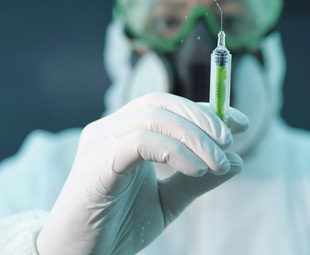Ebola alert!

Let’s put things into context: HIV/Aids, cigarettes and even road fatalities currently kill far more people than Ebola – even though over 10 000 people have now contracted this virus. But, if Ebola does come to South Africa (as I pen this column, we’re currently E-free), it could have a crippling impact on our country and its economy …
We’ve all been reading masses of stuff about Ebola. Horror stories pertaining to its contraction and impact abound. It’s even been mooted as a possible bioterrorism weapon! Of course, this is a truly daft notion – it’s tricky and highly dangerous to handle the virus … so the terrorists would probably end up dead (which, of course, is not entirely a bad thing).
Bearing this in mind, and also noting that it could impact on business in South Africa, I decided to do a little bit of research, and hopefully separate the facts from the fallacies. So here goes …
Let’s start at the very beginning. While much has been said and written about the disease of late, it’s not actually new – Ebola first came to the fore in 1976 in Africa. According to the Centres for Disease Control and Prevention, the virus was named after the Ebola River, which is where it was first spotted.
Technically, there are actually five different Ebola viruses – Zaire, Bundibugyo, Sudan, Taï Forest and Reston. The latter affects animals only; the other four can be contracted by humans and animals.
All five are very nasty viruses, in that they kill 90 percent of the people they infect; the most notable symptoms being a dangerously high fever and extensive internal bleeding.
Now the million-dollar question: how do you catch it? According to the medical experts, Ebola can only be transmitted by direct contact with the blood, secretions, faeces or body fluids of someone who is infected.
The virus is not transmitted through the air. Because the virus is carried by animals, it’s possible to catch it when, for instance, killing and butchering an infected animal.
Workers in laboratories can also become infected (much like the aforementioned terrorists) by coming into direct contact with the virus. Once the virus has been transmitted, it takes two to 21 days for the symptoms to manifest themselves.
So, how do you know that someone has Ebola? Well, many of the symptoms are not unique to this virus – they include high fevers, headaches, sore muscles, stomach pain, diarrhoea, a sore throat, red and itchy eyes and even hiccups. Once the person gets really ill, vomiting, rashes and severe bleeding (both internal and external) follow. This is followed by terrible chest pains, acute shock and, sadly, death.
Until recently, it was believed that there was no guaranteed treatment or cure for the disease. The World Health Organization has noted that “there is no specific treatment or vaccine” for Ebola. This situation is changing fast, however, as medical professionals gain a better understanding of the virus. Recently, for instance, a second Dallas nurse infected with Ebola was cured and appeared at a typically triumphant news conference to mark her release from Emory University Hospital in Atlanta.
“I’m so grateful to be well. First and foremost, I want to thank God,” said Amber Joy Vinson, 29, who was infected with the virus at a Dallas hospital while caring for Thomas Eric Duncan, the Liberian man who died of Ebola in October.
“While this is a day for celebration and gratitude, I ask that we not lose focus on the thousands of families that continue to labour under the burden of this disease in West Africa,” she added.
Of course, prevention is much better than cure. So what can be done to prevent the spread of the disease in the first place? It’s vitally important to avoid any contact with the blood or secretions of an infected patient. Then, if that patient dies, it’s vital to avoid direct contact with the corpse. This is obviously tricky for medical personnel; we have all seen how they are suiting up in personal protective equipment (PPE) to avoid any possible interaction with bodily fluids.
The ideal solution would clearly be vaccination. The good news is that Novavax, an American clinical-stage biopharmaceutical company that specialises in this field, is already a long way down the road in this regard.
“We are developing our recombinant Ebola GP vaccine using the same platform we used to develop vaccine candidates against several pathogens including respiratory syncytial virus (RSV), seasonal and pandemic influenza, and Middle Eastern Respiratory Syndrome (MERS),” Stanley Erck, president and CEO of the company, tells SHEQ MANAGEMENT.
“Our proprietary platform allows us to quickly develop, and manufacture an Ebola vaccine candidate at large scale, which we believe can provide a necessary tool to fight this global health crisis,” he adds.
Novavax has already tested the vaccination on animals and a Phase One clinical trial to evaluate the safety and immunogenicity of the vaccine in humans is planned for December 2014. A total of 150 people will participate in this trial. If everything goes according to plan, manufacturing of this vaccine is planned for the first quarter of 2015.
We can only hope and pray that this vaccination is available before Ebola arrives in South Africa, because, unfortunately, the arrival of this virus is much like the death of Nelson Mandela. It’s something we will dread, but we know it’s inevitable.



